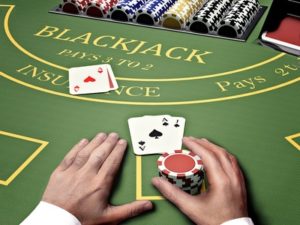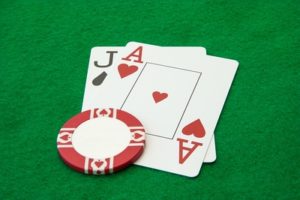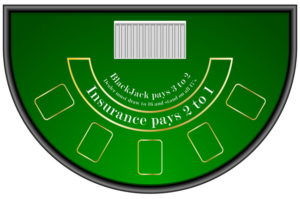 Blackjack is an almost fair casino game, in the sense that it is actually symmetric for the players and the bank and some asymmetric aspects tend to favour the player.
Blackjack is an almost fair casino game, in the sense that it is actually symmetric for the players and the bank and some asymmetric aspects tend to favour the player.
Those considering blackjack as the game with the best odds are not exaggerated at all. I would only add ‘over the long run’, as the assertion is true when taking ‘odds’ with the meaning of expected value (if we take it to be winning probability, there are other casino games, like roulette, offering far higher odds of winning for certain bets).
Indeed, with a house edge of about 0.5% for the classical version of blackjack with basic strategy, this game is in the top of the low – house edge casino games.
Fairness can be also seen in the balance of the winning probabilities: the apriori probability (before any card is dealt) for the player to win the game is 42.43%, 8.48% is for a tie, and 49.09% is for the dealer to win.
This tight balance changes with every new card coming into play and no intermediary result is sure for winning the hand. Totals like 19, 20, and even 21 in player’s hand may be beaten by the dealer.
In this article we will see what the probabilities for a hand are to achieve 20 points, 21 points, or blackjack, and the conditional probabilities for such a hand to win or to loose.
Dealer’s odds for 20, 21, and blackjack
| Dealer’s result | Probability |
|---|---|
| 20 | 0.1803 |
| 21 | 0.0727 |
| BJ | 0.0473 |
Before any card is dealt, the dealer may achieve as their final hand 20 points, 21 points, or blackjack with the apriori probabilities shown above.
The highest probability for such hands is 18% for 20 points, while the blackjack probability is quite low, less than 5%. But this is not a good reason for the player to stay at some totals below 20 points, because these apriori probabilities may change dramatically with every new card dealt.
Let’s see now how these probabilities above change with the first card dealt to the dealer (the face-up card). The probabilities for the dealer to achieve 20, 21, or BJ conditional on their first card are noted in the table below:
| Dealer’s first card | ||||||||||
|---|---|---|---|---|---|---|---|---|---|---|
| Dealer’s result | 2 | 3 | 4 | 5 | 6 | 7 | 8 | 9 | 10 | A |
| 20 | 0.1240 | 0.1203 | 0.1165 | 0.1131 | 0.1017 | 0.0786 | 0.0694 | 0.1200 | 0.3422 | 0.1308 |
| 21 | 0.1180 | 0.1147 | 0.1112 | 0.1082 | 0.0972 | 0.0741 | 0.0694 | 0.0608 | 0.0345 | 0.0539 |
| BJ | 0.0000 | 0.0000 | 0.0000 | 0.0000 | 0.0000 | 0.0000 | 0.0000 | 0.0000 | 0.0769 | 0.3077 |
Table 1.
The odds for a total of 20 remained under the apriori 18% except when the dealer’s first card is worth 10 points, when it increases to 34%. In such a situation, if you hold 19 points you will think twice before deciding to stay, but your decision can also be influenced by the cards in your hand, as they change the apriori probability, too.
The odds for a total of 21 increase for a value of 2 to 7 as the dealer’s first card, reaching a maximum of about 12%. As for a blackjack, we can see that the dealer’s first card get them increased to 7.7% for a value of 10 and jumped to 30.7% for an ace. This latter probability is of course relevant for the insurance bet. While the probability itself is not high (it’s below 50%), the payout odds of insurance (2 to 1) make the bet looking attractive.
The expected value of the insurance bet in a blackjack game where cards are dealt from a multi-deck stack is: EV(%) = 0.3077 x 2 – (1 – 0.3077) = – 0.0763.
Over the long run, you may expect to loose about 7.7% of your wagers for insurance. This is more than 15 times the standard house edge of the game.
Player’s odds for 20, 21, and blackjack
 The same apriori probabilities stand for the player to achieve 20 points, 21 points or blackjack as from the dealer’s perspective (18.03%, 7.27%, and 4.73% respectively). These change a bit with the dealer’s first card, but not significantly, especially when several decks are in play.
The same apriori probabilities stand for the player to achieve 20 points, 21 points or blackjack as from the dealer’s perspective (18.03%, 7.27%, and 4.73% respectively). These change a bit with the dealer’s first card, but not significantly, especially when several decks are in play.
Assume now you are in the lucky position where you reached such a total. What are the odds to loose the hand if you stay? (Of course, it is wise to stay at 20 points, as the probability to bust with the next card is 92%.)
The next table notes the probabilities for the player to win if they decide not to draw, conditioned on the dealer’s first card.
| Dealer’s first card | ||||||||||
|---|---|---|---|---|---|---|---|---|---|---|
| Player’s result | 2 | 3 | 4 | 5 | 6 | 7 | 8 | 9 | 10 | A |
| BJ | 1.0000 | 1.0000 | 1.0000 | 1.0000 | 1.0000 | 1.0000 | 1.0000 | 1.0000 | 0.9231 | 0.6923 |
| 21 | 0.8820 | 0.8853 | 0.8880 | 0.8918 | 0.9028 | 0.9259 | 0.9306 | 0.9392 | 0.8886 | 0.6384 |
| 20 | 0.7580 | 0.7650 | 0.7723 | 0.7787 | 0.8011 | 0.8473 | 0.8612 | 0.8192 | 0.5464 | 0.5076 |
Table 2.
We can see that, except for the cases with dealer’s 10 or ace at your 20 points and perhaps at dealer’s ace and your 21 points, your odds of winning are very high.
For computing the probability of loosing with each of such hands, we have to subtract from 1 the probability from the above table and the probability of a tie (from Table 1.) We get the following values:
| Dealer’s first card | ||||||||||
|---|---|---|---|---|---|---|---|---|---|---|
| Player’s result | 2 | 3 | 4 | 5 | 6 | 7 | 8 | 9 | 10 | A |
| BJ | 0.0000 | 0.0000 | 0.0000 | 0.0000 | 0.0000 | 0.0000 | 0.0000 | 0.0000 | 0.0000 | 0.0000 |
| 21 | 0.0000 | 0.0000 | 0.0000 | 0.0000 | 0.0000 | 0.0000 | 0.0000 | 0.0000 | 0.0769 | 0.3077 |
| 20 | 0.1180 | 0.1147 | 0.1112 | 0.1082 | 0.0972 | 0.0786 | 0.0694 | 0.0608 | 0.1114 | 0.3616 |
Table 3.
What does this table tell us? If you have 21 points, you should be a bit worried only when the dealer’s face-up card is an ace. In such situation, the dealer can beat you with a 30.77% probability (by achieving BJ). The expected value of this bet is 0.3307 (positive).
If you have 20 points and stay, the probability for the dealer to beat you ranges between 6% and 12% for their card valued between 2 and 10 (It is interesting that dealer’s first card of 10 points does not result in a probability of loosing much higher than for other values less than 10.)
The only case when you should be a bit worried is when the dealer’s first card is an ace, as the probability that they will beat you is about 36%. This of course does not mean that you should hit. Both the winning probability and the expected value (positive 0.1461) are in your favor, not mentioning the probability to bust with the next card.
Conclusion
 Hands of 20, 21, or BJ are hard enough to achieve (given their apriori probabilities). This stands for either the player or the dealer. With a hand of 20 points you should stay, as even the highest possible probability of loosing (against dealer’s face-up card ace) keeps a positive expectation of the bet.
Hands of 20, 21, or BJ are hard enough to achieve (given their apriori probabilities). This stands for either the player or the dealer. With a hand of 20 points you should stay, as even the highest possible probability of loosing (against dealer’s face-up card ace) keeps a positive expectation of the bet.
Long-run players will see from time to time their 20-point hand loosing against the dealer’s hand with ace (more precisely, about once in 2.8 such situations in average), but this is just what probability tells us. Positive expectation is a rare flower in casino games and we should take it when we are lucky enough to find it.
About The Author
The author of this page is Dr. Catalin Barboianu. Catalin is a mathematician specialising in gaming and responsible gambling and a research associate at the University of Bucharest.
